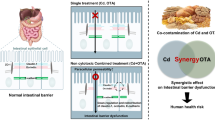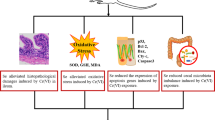Abstract
Selenium (Se) is found in inorganic and organic forms, both of which are commonly used in animal feed supplements. The aim of this study was to determine the impact of the chemical form of Se on its associated ameliorative effects on cadmium (Cd)-induced DNA damage in a porcine model. At a cellular level, Cd mediates free oxygen radical production leading in particular to DNA damage, with consequential mutagenesis and inhibition of DNA replication. In this study, porcine jejunal epithelial cells (IPEC-J2) were pre-incubated for 48 h with one of Se-yeast (Sel-Plex), selenomethionine (Se-M), sodium selenite (Se-Ni) or sodium selenate (Se-Na). The effects of this supplementation on cell viability and DNA damage following cadmium chloride (CdCl2) exposure were subsequently evaluated. IPEC-J2 cells were cultivated throughout in medium supplemented with porcine serum to generate a superior model that recapitulated the porcine gut epithelium. The results illustrated that Se antioxidant effects were both composition- and dose-dependent as evident from cell viability (Alamar Blue and 5-carboxyfluorescein diacetate acetoxymethyl ester) and DNA damage assays (Comet and TUNEL). Both the Se-yeast and Se-M organic species, when used at the European Food Safety Authority guideline levels, had a protective effect against Cd-induced DNA damage in the IPEC-J2 model system whereas for inorganic Se-Ni and Se-Na sources no protective effects were observed and in fact these were shown to enhance the negative effects of Cd-induced DNA damage. It can be concluded that nutritional supplementation with organoselenium may protect porcine gut integrity from damage induced by Cd.





Similar content being viewed by others
References
Scientific Opinion of the Panel on Contaminants in the Food Chain on a request from the European Commission on cadmium in food. EFSA Journal (2009) 980, 1–139. doi:10.2903/j.efsa.2009.980
European Food Safety Authority (2012) Cadmium dietary exposure in the European population. EFSA J 10(1):2551–2588. doi:10.2903/j.efsa.2012.2551
Fasanya-Odewumi C, Latinwo LM, Ikediobi CO, Gilliard L, Sponholtz G, Nwoga J, Stino F, Hamilton N, Erdos GW (1998) The genotoxicity and cytotoxicity of dermally-administered cadmium: effects of dermal cadmium administration. Int J Mol Med 1:1001–1007. doi:10.3892/ijmm.1.6.1001
Bertin G, Averbeck D (2006) Cadmium: cellular effects, modifications of biomolecules, modulation of DNA repair and genotoxic consequences (a review). Biochimie 88:1549–1559. doi:10.1016/j.biochi.2006.10.001
Bampidis VA, Nistor E, Nitas D (2013) Arsenic, cadmium, lead and mercury as undesirable substances in animal feeds. Sci Pap Anim Sci Biotechnol 46:17–22
Bergeron PM, Jumarie C (2006) Characterization of cadmium uptake in human intestinal crypt cells HIEC in relation to inorganic metal speciation. Toxicology 219:156–166. doi:10.1016/j.tox.2005.11.016
Ninkov M, Popov A, Demenesku J, Mirkov I, Mileusnic D, Petrovic A, Grigorov I, Zolotarevski L, Tolinacki M, Kataranovski D, Brceski I, Kataranovski M (2015) Toxicity of oral cadmium intake: impact on gut immunity. Toxicol Lett 237:89–99. doi:10.1016/j.toxlet.2015.06.002
McKelvey SM, Horgan KA, Murphy RA (2014) Chemical form of selenium differentially influences DNA repair pathways following exposure to lead nitrate. J Trace Elem Med Biol. doi:10.1016/j.jtemb.2014.06.005
Zeng H, Combs GF (2008) Selenium as an anticancer nutrient: roles in cell proliferation and tumor cell invasion. J Nutr Biochem 19:1–7. doi:10.1016/j.jnutbio.2007.02.005
Brummer M, Hayes S, Dawson KA, Lawrence LM (2013) Measures of antioxidant status of the horse in response to selenium depletion and repletion. J Anim Sci 91:2158–2168. doi:10.2527/jas.2012-5794
Ward P, Connolly C, Murphy R (2013) Accelerated determination of selenomethionine in selenized yeast: validation of analytical method. Biol Trace Elem Res 151:446–450. doi:10.1007/s12011-012-9571-x
Ishii M, Ogata H, Shimizu H, Takeuchi Y, Nozawa T, Yamamoto Y, Okamoto T, Shimamura T, Utsumi A, Jitsukawa T, Endo M (2002) Effects of vitamin E and selenium administration on pregnant, heavy draft mares on placental retention time and reproductive performance and on white muscle disease in their foals. J Equine Vet Sci 22:213–220. doi:10.1053/jevs.2002.34302
Galbraith ML, Vorachek WR, Estill CT, Whanger PD, Bobe G, Davis TZ, Hall JA (2015) Rumen microorganisms decrease bioavailability of inorganic selenium supplements. Biol Trace Elem Res 171:338–343. doi:10.1007/s12011-015-0560-8
O'Dell BL, Sunde RA 1997 Handbook of nutritionally essential minerals. New York: Marcel Dekker, Inc; 275–334. ISBN 0–8247–9312-9
De Rosa V, Erkekoğlu P, Forestier A, Favier A, Hincal F, Diamond AM, Douki TRW (2012) Low doses of selenium specifically stimulate the repair of oxidative DNA damage in LNCaP prostate cancer cells. Free Radic Res 46:105–116. doi:10.3109/10715762.2011.647009
Liu L, Yang B, Cheng Y, Lin H (2015) Ameliorative effects of selenium on cadmium-induced oxidative stress and endoplasmic reticulum stress in the chicken kidney. Biol Trace Elem Res 167:308–319. doi:10.1007/s12011-015-0314-7
Jabeen F, Chaudhry AS (2011) Effects of cadmium chloride and sodium selenite alone or in combination on the liver of male Sprague-Dawley rats assessed by different assays. Biol Trace Elem Res 143:1077–1090. doi:10.1007/s12011-010-8946-0
Yu, RA, Chen X (2004) Effect of selenium on rat hepatocellular DNA damage induced by cadmium in vitro. Chinese J Prev Med 38:29–32. doi: DOI:. 10.3760/J: ISSN: 0253–9624.2004.01.009
Bolkent S, Koyuturk M, Bulan OK, Tunali S, Yanardag R, Tabakoglu AO (2007) The effects of combined alpha-tocopherol, ascorbic acid, and selenium against cadmium toxicity in rat intestine. J Environ Pathol Toxicol Oncol 26:21–27
Forrester LW, Latinwo LM, Fasanya-Odewumi C, Ikediobi C, Abazinge MD, Mbuya O, Nwoga J (2000) Comparative studies of cadmium-induced single strand breaks in female and male rats and the ameliorative effect of selenium. Int J Mol Med 6:449–501. doi:10.3892/ijmm.6.4.449
Schrauzer GN, Surai PF (2009) Selenium in human and animal nutrition: resolved and unresolved issues. A partly historical treatise in commemoration of the fiftieth anniversary of the discovery of the biological essentiality of selenium, dedicated to the memory of Klaus Schwarz (1914-1978). Crit Rev Biotechnol 29:2–9. doi:10.1080/07388550902728261
Surai PF, Fisinin VI (2016) Selenium in sow nutrition. Anim Feed Sci Technol 211:18–30. doi:10.1016/j.anifeedsci.2015.11.006
Hamilton-Koch W, Snyder RD, Lavelle JM (1985) Metal-induced DNA damage and repair in human diploid fibroblasts and Chinese hamster ovary cells. Chem Biol Interact 59:17–28. doi:10.1016/S0009-2797(86)80052-7
Bera S, De Rosa V, Rachidi W, Diamond AM (2013) Does a role for selenium in DNA damage repair explain apparent controversies in its use in chemoprevention? Mutagenesis 28:127–134. doi:10.1093/mutage/ges064
Geens MM, Niewold TA (2011) Optimizing culture conditions of a porcine epithelial cell line IPEC-J2 through a histological and physiological characterization. Cytotechnology 63:415–423. doi:10.1007/s10616-011-9362-9
Schierack P, Nordhoff M, Pollmann M, Weyrauch KD, Amasheh S, Lodemann U, Jores J, Tachu B, Kleta S, Blikslager A, Tedin K, Wieler LH (2006) Characterization of a porcine intestinal epithelial cell line for in vitro studies of microbial pathogenesis in swine. Histochem Cell Biol 125:293–305. doi:10.1007/s00418-005-0067-z
Zakrzewski SS, Richter JF, Krug SM, Jebautzke B, Lee IF, Rieger J, Sachtleben M, Bondzio A, Schulzke JD, Fromm M, Günzel D (2013) Improved cell line IPEC-J2, characterized as a model for porcine jejunal epithelium. PLoS One 8:e79643. doi:10.1371/journal.pone.0079643
Bopp SK, Lettieri T (2008) Comparison of four different colorimetric and fluorometric cytotoxicity assays in a zebrafish liver cell line. BMC Pharmacol 11:1–11. doi:10.1186/1471-2210-8-8
Gyori BM, Venkatachalam G, Thiagarajan PS, Hsu D, Clement M (2014) Redox Biology OpenComet : an automated tool for comet assay image analysis. Redox Biol 2:457–465. doi:10.1016/j.redox.2013.12.020
Azqueta A, Collins AR (2013) The essential comet assay: a comprehensive guide to measuring DNA damage and repair. Arch Toxicol 87:949–968. doi:10.1007/s00204-013-1070-0
Nandhakumar S, Parasuraman S, Shanmugam MM, Rao KR, Chand P, Bhat BV (2011) Evaluation of DNA damage using single-cell gel electrophoresis (comet assay). J Pharmacol Pharmacother 2(2):107–111. doi:10.4103/0976-500X.81903
Zhou YJ, Zhang SP, Liu CW, Cai YQ (2009) The protection of selenium on ROS mediated-apoptosis by mitochondria dysfunction in cadmium-induced LLC-PK(1) cells. Toxicol in Vitro 23:288–294. doi:10.1016/j.tiv.2008.12.009
Lawal AO, Ellis E (2010) Differential sensitivity and responsiveness of three human cell lines HepG2 , 1321N1 and HEK 293 to cadmium. J Toxicol Sci 35:465–478. doi:10.2131/jts.35.465
Letavayova L, Vlckova V, Brozmanova J (2006) Selenium : from cancer prevention to DNA damage. Toxicology 227:1–14. doi:10.1016/j.tox.2006.07.017
Fernandes AP, Gandin V (2015) Selenium compounds as therapeutic agents in cancer. Biochim Biophys Acta 1850:1642–1660. doi:10.1016/j.bbagen.2014.10.008
EFSA panel on additives and products or substances used in animal feed (FEEDAP) (2011) Scientific opinion on safety and efficacy of Sel-Plex ® (organic form of selenium produced by Saccharomyces cerevisiae CNCM I-3060 ) for all species. 9:1–52. doi: 10.2903/j.efsa.2011.2110.
Shen HM, Yang CF, Ong CN (1999) Sodium selenite-induced oxidative stress and apoptosis in human hepatoma HepG2 cells. Int J Cancer 81:820–828. doi:10.1002/(SICI)1097-0215(19990531)81:5<820::AID-IJC25>3.0.CO;2-F
Bandura L, Drukala J, Wolnicka-Glubisz A, Björnstedt M, Korohoda W (2005) Differential effects of selenite and selenate on human melanocytes, keratinocytes and melanoma cells. Biochem Cell Biol 211:196–211. doi:10.1139/O04-130
Speit G, Hartmann A (2006) The comet assay: a sensitive genotoxicity test for the detection of DNA damage and repair. Methods Mol Biol 314:275–286. doi:10.1385/1-59259-973-7:275
Lavu RVS, Van de Wiele T, Pratti VL, Tack F, Du Laing G (2016) Selenium bioaccessibility in stomach, small intestine and colon: comparison between pure Se compounds, Se-enriched food crops and food supplements. Food Chem 197:382–387. doi:10.1016/j.foodchem.2015.08.001
Devos C, Sandra K, Sandra P (2002) Capillary gas chromatography inductively coupled plasma mass spectrometry (CGC-ICPMS) for the enantiomeric analysis of D,L-selenomethionine in food supplements and urine. J Pharm Biomed Anal 27:507–514. doi:10.1016/S0731-7085(01)00576-3
Barger JL, Kayo T, Pugh TD, Vann JA, Power R, Dawson K, Weindruch R, Prolla TA (2012) Gene expression profiling reveals differential effects of sodium selenite, selenomethionine, and yeast-derived selenium in the mouse. Genes Nutr 7:155–165. doi:10.1007/s12263-011-0243-9
Shi K, Jiang Q, Li Z, Shan L, Li F, An J, Yang Y, Xu C (2013) Sodium selenite alters microtubule assembly and induces apoptosis in vitro and in vivo. J Hematol Oncol 6:1–9. doi:10.1186/1756-8722-6-7
Gu P, Bernhard D (2016) Cadmium overkill: autophagy, apoptosis and necrosis signalling in endothelial cells exposed to cadmium. Cell Mol Life Sci 73:1699–1713. doi:10.1007/s00018-015-2094-9
Acknowledgments
SL is the recipient of a postgraduate studentship from Alltech Ltd.
Author information
Authors and Affiliations
Corresponding author
Additional information
Blanaid White and Dermot Walls made an equal contribution to this work.
Rights and permissions
About this article
Cite this article
Lynch, S.J., Horgan, K.A., White, B. et al. Selenium Source Impacts Protection of Porcine Jejunal Epithelial Cells from Cadmium-Induced DNA Damage, with Maximum Protection Exhibited with Yeast-Derived Selenium Compounds. Biol Trace Elem Res 176, 311–320 (2017). https://doi.org/10.1007/s12011-016-0828-7
Received:
Accepted:
Published:
Issue Date:
DOI: https://doi.org/10.1007/s12011-016-0828-7




